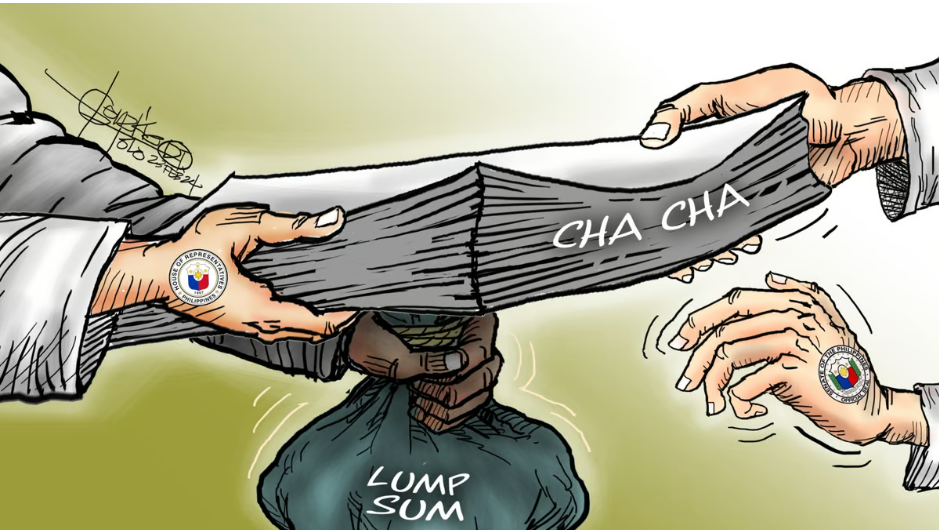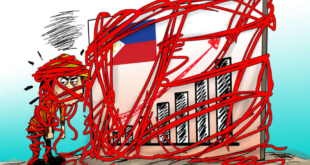 A strong deterrent to efforts to mangle the yearly budget and the culprits getting away with it is Executive Secretary Lucas Bersamin, who, as Associate Justice, was the “ponente” or author of the 2014 Supreme Court ruling that declared the Disbursement Acceleration Program, or DAP, unconstitutional. He later became Chief Justice.
A strong deterrent to efforts to mangle the yearly budget and the culprits getting away with it is Executive Secretary Lucas Bersamin, who, as Associate Justice, was the “ponente” or author of the 2014 Supreme Court ruling that declared the Disbursement Acceleration Program, or DAP, unconstitutional. He later became Chief Justice.
The landmark ruling required the “authors, proponents, and implementors” of the illegal program to be held accountable.
Efforts to create lump sums in both the Executive and Legislative branches are being strongly suspected amid the revitalized Charter change or cha-cha campaign, which government leaders said would be limited to the economic provisions, but constitutional experts said it is a dangerous undertaking.
Constitutionalists said nobody can stop members of Congress in a constituent assembly from overhauling the Basic Law once cha-cha is initiated.
With 2025 being an election year, the efforts to build up campaign funds will be a compelling reason to come up with discretionary or unprogrammed funds, which are items inserted in the budget that the Executive needs to fund.
The DAP was a classic abuse of the Palace’s authority to reallocate funds.
Some P150 billion was misappropriated from the budget to build up the DAP, which was supposedly an economic stimulus program during the term of the late President Noynoy Aquino.
It became a slush fund of the President and the Liberal Party. It was primarily used to underwrite the impeachment and the subsequent ouster of the late Chief Justice Renato Corona.
Between 2011 and 2013, the DAP list from the Department of Budget and Management showed 116 projects funded, with P144.4 billion coming mainly from the so-called savings of agencies.
The SC, in its ruling, indicated that while the Executive had the power to implement measures to stimulate the economy, the creation of the DAP violated the doctrine of separation of powers after the Palace declared savings before the end of the fiscal year and without complying with the statutory definition of savings contained in the budget law.
The SC also rejected the cross-border transfer of savings among agencies, the funding of projects, activities, and programs not covered under the budget law, and the use of unprogrammed funds without meeting the requirement to come from a budget surplus.
The DBM, during the tenure of Budget Secretary Butch Abad, craftily tried to satisfy that requirement by declaring forced savings among agencies and thereafter saying the projects funded with DAP money were undertaken in good faith.
The Bersamin-penned decision cited the doctrine of operative fact that did away with the need to undo the projects resulting from the unconstitutional act.
The SC then stated that the doctrine couldn’t apply “to the authors, proponents, and implementors of the DAP unless there were concrete findings of good faith in their favor by the proper tribunals determining their criminal, civil, administrative, and other liabilities.”
Applied to the feud on the use of supposed social amelioration projects to achieve a political agenda, such as building a campaign kitty or convincing Filipinos to affix their signatures to a People’s Initiative, it would be hard to find good faith.
Senators claimed, for instance, that they did not know that the P26.7-billion Ayuda para sa Kapos ang Kita Program, or AKAP, existed in the budget after it was inserted in the bicameral conference committee.
Suspicions were thus raised that the program under the Department of Social Welfare and Development financed the mammoth undertaking of collecting signatures of 12 percent of the population under the PI program.
Good faith, as required in the DAP ruling, is sorely lacking in the recent budget imbroglio.
*****
Credit belongs to: tribune.net.ph
 Atin Ito First Filipino Community Newspaper in Ontario
Atin Ito First Filipino Community Newspaper in Ontario






